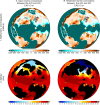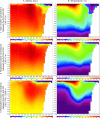Ocean freshening near the end of the Mesozoic
- PMID: 40769971
- PMCID: PMC12328591
- DOI: 10.1038/s41467-025-62189-9
Ocean freshening near the end of the Mesozoic
Abstract
Paleogeographic changes have significantly shaped ocean circulation and climate dynamics throughout Earth's history. This study integrates geological proxies with climate simulations to assess how ocean gateway evolution influenced ocean salinity near the end of the Mesozoic (~66 Ma). Our modeling results demonstrate that 1) Central American Seaway shoaling reorganizes ocean currents, and 2) Arctic marine gateway restrictions, confining Arctic-Global Ocean exchange exclusively to the Greenland-Norwegian Seaway, drive Arctic Ocean surface freshening and southward outflow of buoyant, low-salinity waters. However, only the combined effect of these two factors leads to both Arctic freshening and increased water mass stratification in the Greenland-Norwegian Seaway, proto-North Atlantic, and the Western Tethys. This scenario aligns with Maastrichtian palynological, micropaleontological, and geochemical records from high- and low-latitude sites. Our findings highlight the profound impact of these latest Cretaceous paleogeographic reconfigurations in altering global salinity patterns, underscoring their role as key drivers of global climate dynamics.
© 2025. The Author(s).
Conflict of interest statement
Competing interests: We declare that the authors have no competing interests as defined by Nature Portfolio, or other interests that might be perceived to influence the results and/or discussion reported in this paper.
Figures









References
-
- Ladant, J. B. et al. Paleogeographic controls on the evolution of Late Cretaceous ocean circulation. Climate16, 973–1006 (2020).
-
- Laugié, M. et al. Exploring the impact of Cenomanian paleogeography and marine gateways on oceanic oxygen. Paleoceanogr. Paleoclimatol.36, e2020PA004202 (2021).
-
- Niezgodzki, I., Knorr, G., Lohmann, G., Tyszka, J. & Markwick, P. J. Late Cretaceous climate simulations with different CO2 levels and subarctic gateway configurations: A model-data comparison. Paleoceanography32, 980–998 (2017).
-
- Brass, G. W., Southam, J. R. & Peterson, W. H. Warm saline bottom water in the ancient ocean. Nature296, 620–623 (1982).
Grants and funding
LinkOut - more resources
Full Text Sources

